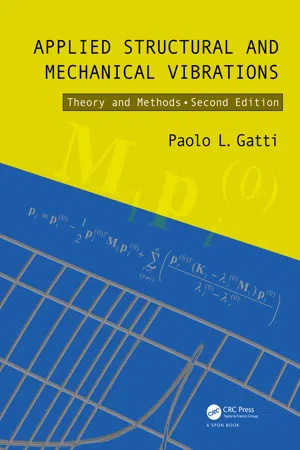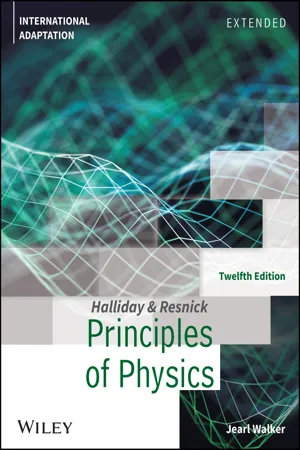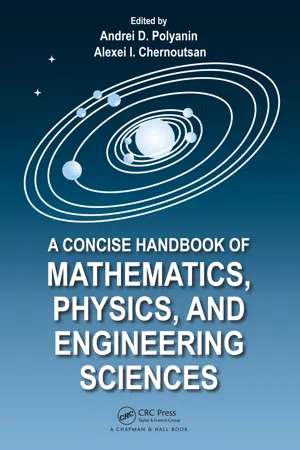Physics
Angular Frequency and Period
Angular frequency is a measure of how quickly an object moves through a complete cycle of motion in circular or oscillatory systems. It is denoted by the symbol ω and is related to the period T by the equation ω = 2π/T. The period is the time it takes for one complete cycle of motion to occur.
Written by Perlego with AI-assistance
Related key terms
1 of 5
8 Key excerpts on "Angular Frequency and Period"
- eBook - PDF
Applied Structural and Mechanical Vibrations
Theory and Methods, Second Edition
- Paolo L. Gatti(Author)
- 2014(Publication Date)
- CRC Press(Publisher)
In practical cases, it is often the ability to reproduce the data by a controlled experiment that pro-vides a general criterion to distinguish between the two. 1.3 SOME DEFINITIONS AND METHODS As stated in the introduction, the particular behaviour of a particle, a body or a complex system that moves about an equilibrium position is called oscil-latory motion. It is then natural to try a description of such a particle, body or system by an appropriate function of time x ( t ), whose physical meaning depends on the scope of the investigation and, as often happens in practice, on the available measuring instrumentation: it might be displacement, veloc-ity, acceleration, stress or strain in structural dynamics; pressure or density in acoustics; current or voltage in electronics or any other time-varying quantity. A function that repeats itself exactly after certain intervals of time is called periodic . The simplest case of periodic motion is called harmonic (or sinusoidal) and is mathematically represented by a sine or cosine function; for example x t X t ( 29 = -( 29 cos ω θ (1.4) where: X is the maximum , or peak amplitude (in the appropriate units) ω t − θ is the phase angle (in radians) ω is the angular frequency (in rad/s) θ is the initial phase angle (in radians), which, in turn, depends on the choice of the time origin and can be taken equal to zero if there is no rela-tive reference to other sinusoidal functions The time between two identical conditions of motion is the period T . It is measured in seconds and is the inverse of the frequency ν = ω /2 π , which is expressed in hertz (Hz, with dimensions of s −1 ). As is probably well known to the reader, frequency represents the number of cycles per unit time and for the harmonic function (Equation 1.4) we have the relations ω πν π ω = = = 2 1 2 , T ν (1.5) A plot of Equation 1.4, amplitude versus time, is illustrated in Figure 1.1 where the peak amplitude is taken as X = 1 and the initial phase angle is θ = 0. - eBook - PDF
Workshop Physics Activity Guide Module 2
Mechanics II
- Priscilla W. Laws, David P. Jackson, Brett J. Pearson(Authors)
- 2023(Publication Date)
- Wiley(Publisher)
The amplitude of oscillation is assumed to be positive. Phase: Qualitatively, the phase represents how far along an object is in its oscillation. For example, the phase describes whether you are near the beginning, middle, or end of the oscillation. Phase is the trickiest of these concepts to understand, so we will postpone further discussion until later in this unit. Two of these definitions, frequency and period, are closely related to each other. By observing the systems shown in Fig. 14.1, you should be able to find a mathematical equation that relates the frequency of a given oscillating system to its period. Warning! If you add too much mass to a spring, it will become permanently deformed and will no longer act like a spring (i.e., it will be ruined). Please be careful! Your instructor may have specific instructions for what mass to use. 14.2.2. Activity: Relating Period and Frequency Observe the three systems discussed above. Use a ruler or protractor to mea- sure the amplitude of oscillation for each case. 1 Then use a stopwatch to measure both the average period and frequency. (Don’t try to measure the time of a single oscillation or the number of cycles in one second; instead, measure the time of many oscillations or the number of cycles in a longer time and then divide, as this produces a much better average.) Note: Your goal is to separately measure both the period and frequency to verify the relation between them. 1 For the peg on a rotating disk, you will need to think carefully about how to measure the amplitude. UNIT 14: SIMPLE HARMONIC MOTION 463 a. Amplitude: Pendulum (rad) _______________________ Mass on spring (m) ____________________ Particle on wheel (m) __________________ b. Period (s): Pendulum ___________________________ Mass on spring _______________________ Particle on wheel ______________________ c. Frequency (Hz): Pendulum ___________________________ Mass on spring _______________________ Particle on wheel ______________________ d. - David Halliday, Robert Resnick, Jearl Walker(Authors)
- 2023(Publication Date)
- Wiley(Publisher)
Let’s use Eq. 15.1.3 to express this condition, but let’s also just set ϕ = 0 to get it out of the way. Returning to the same position can then be written as x m cos ωt = x m cos ω(t + T). (15.1.4) The cosine function first repeats itself when its argument (the phase, remember) has increased by 2π rad. So, Eq. 15.1.4 tells us that ω(t + T) = ωt + 2π or ωT = 2π. Thus, from Eq. 15.1.2 the angular frequency is ω = 2π ___ T = 2πf. (15.1.5) The SI unit of angular frequency is the radian per second. We’ve had a lot of quantities here, quantities that we could experimentally change to see the effects on the particle’s SHM. Figure 15.1.5 gives some examples. The curves in Fig. 15.1.5a show the effect of changing the amplitude. Both curves have the same period. (See how the “peaks” line up?) And both are for ϕ = 0. (See how the maxima of the curves both occur at t = 0?) In Fig. 15.1.5b, the two curves have the same amplitude x m but one has twice the period as the other (and thus half FIGURE 15.1.3 A handy guide to the quantities in Eq. 15.1.3 for simple harmonic motion. Displacement at time t Amplitude Angular frequency Time Phase constant or phase angle Phase x (t ) = x m cos(ωt + ϕ) 0 +x m –x m 0 rad rad 3 2 1 2 rad π π π FIGURE 15.1.4 Values of ϕ corre- sponding to the position of the particle at time t = 0. and the displacement x just then. 15.1.15 For any given instant in an oscillation, apply the relationship between acceleration a, angular frequency ω, and displacement x. 15.1.16 Given data about the position x and velocity v at one instant, determine the phase ωt + ϕ and phase constant ϕ. 15.1.17 For a spring–block oscillator, apply the relationships between spring constant k and mass m and either period T or angular frequency ω. 15.1.18 Apply Hooke’s law to relate the force F on a simple harmonic oscillator at any instant to the displacement x of the oscillator at that instant. 15.1 Simple Harmonic Motion 415 the frequency as the other).- eBook - PDF
- Michael Tammaro(Author)
- 2019(Publication Date)
- Wiley(Publisher)
The common abbre- viation for this unit is the Hertz (Hz): 1 Hz = 1 cycle/s I N T E R A C T I V E F E A T U R E Periodic Motion and Simple Harmonic Motion | 283 Animated Figure 11.1.1 illustrates the meaning of frequency and its relationship to period. Four small balls bounce back and forth between immovable barriers. When a ball hits a barrier it reverses direction, maintaining the same speed. The numerical values of the period and frequency are shown. Use these values in Equation 11.1.1 to make sure they are consistent and correct. Animated Figure 11.1.1 Periodic motion for four different frequencies is illustrated. The period is the reciprocal of the frequency: T f 1 = / . I N T E R A C T I V E F E A T U R E Animated Figure 11.1.2 An object rotates in uniform circular motion in a vertical circle. The shadow it casts on the x axis performs simple harmonic motion. I N T E R A C T I V E F E A T U R E In Practice Problem 11.1.1, the frequency depends on the length of travel during a cycle. There is a special kind of periodic motion—simple harmonic motion—for which the frequency and period are independent of the total length of travel during a complete cycle. Simple Harmonic Motion Simple harmonic motion is a special kind of periodic motion. Here we will answer two questions—namely, what is simple harmonic motion and what causes simple harmonic motion? The first question is answered with the help of Animated Figure 11.1.2. A small object (the dark green dot) rotates in uniform circular motion in a vertical circle of radius A. With light from above, the object casts a shadow on a horizontal x axis that is parallel to the shadow’s motion and whose origin ( x 0 = ) is directly below the center of the circle. At time t 0 = , the shadow is at x A = + and the motion begins with counterclockwise rotation at angular speed ω. Activate the animation and watch the motion. (The period of this motion is 2.0 s, so the frequency is 0.50 Hz.) I N T E R A C T I V E F E A T U R E - eBook - PDF
- Ian McDonagh(Author)
- 2014(Publication Date)
- Arnold(Publisher)
9 Oscillations 9.1 Periodic time and frequency An oscillation is defined as a to-and-fro motion about a mean position and is completed when the motion of M in fig. 9.1 is from 0 to A to B and back to 0. Mean position 0 t fc M m i Fig. 9.1 Definition of an oscillation The time required to complete one cycle of the motion is known as the period or periodic time, T, of the oscillation, and the number of cycles made per unit time is known as the frequency, /, of the oscillation. If the periodic time for each successive oscillation is the same (i.e. 7), then frequency = periodic time / -I T which it is useful to remember. The unit for frequency is the hertz (Hz), and for periodic time the second (s). It is important to note that 1 Hz = 1 cycle/second or 1 oscillation/second or 1 revolution/second 9.2 Displacement and amplitude In oscillatory motion, the displacement, x, is measured outwards from either side of the mean position, as shown in fig. 9.2. The maximum displacement on either side of the mean position is known as the amplitude of the motion. 180 or ^ ^ Mean position r _ — 1 Amplitude — I ί x 2 r 1 I Amplitude -~t-— —»-Fig. 9.2 Measurement of displacement and amplitude 9.3 Simple harmonic motion The most common form of oscillatory motion is simple harmonic motion (S.H.M.). An oscillating body will have S.H.M. if, at any instant during the cycle, i) the acceleration of the body is proportional to its displacement from the mean position, and ii) the acceleration of the body is always directed towards the mean position. Consider the motion of Q, which is the projection of P on to the line AB in fig. 9.3. P is rotating in a circle of radius r with uniform angular velocity , causing Q to oscillate between A and B about the mean position 0. In the position shown, where P has rotated through angle Θ in time t, i.e. 0 = , Fig. 9.3 Simple harmonic motion 181 - David Halliday, Jearl Walker, Patrick Keleher, Paul Lasky, John Long, Judith Dawes, Julius Orwa, Ajay Mahato, Peter Huf, Warren Stannard, Amanda Edgar, Liam Lyons, Dipesh Bhattarai(Authors)
- 2020(Publication Date)
- Wiley(Publisher)
However, if we set t = 0 when the particle happens to be at some other position, we need a different value of ø. A few values are indicated in figure 15.5. For example, suppose the particle is at its leftmost position when we happen to start the clock at t = 0. Then our cosine function describes the motion if = rad. To check, substitute t = 0 and = rad into the equation. See, it gives x = −x m just then. Now check the other examples in figure 15.5. FIGURE 15.5 Values of corresponding to the position of the particle at time t = 0. 0 +x m –x m 0 π rad π rad 3 2 1 2 π rad The quantity in our cosine function is the angu- lar frequency of the motion. To relate to the frequency f and the period T, let’s first note that the position x(t) of the particle must (by definition) return to its initial value at the end of a period. That is, if x(t) is the position at some chosen time t, then the particle must return to that same position at time t + T. Let’s use our cosine function to express this condition, but let’s also just set = 0 to get it out of the way. Returning to the same position means that (position at t) = (position at t + T) , which can be written as x m cos t = x m cos (t + T). The cosine function first repeats itself when its argument (the phase, remember) has increased by 2 rad. So, this equation tells us that (t + T) = t + 2 or T = 2. (15.4) Thus, from T = 1/f (which is equation 15.2), the angular frequency is = 2 T = 2f. (15.5) The SI unit of angular frequency is the radian per second. We’ve had a lot of quantities here, quantities that we could experimentally change to see the effects on the particle’s SHM. Here are three examples. • The curves in figure 15.6 show the effect of changing only the amplitude, from x m to x ′ m .- Andrei D. Polyanin, Alexei Chernoutsan(Authors)
- 2010(Publication Date)
- CRC Press(Publisher)
Such oscillations are called beats , ω b = Δ ω is the beat angular frequency, and the period of variation in the amplitude T b = 2 π/ω b is the beat period. If A 1 = A 2 = A , then x ( t ) = 2 A cos parenleftBig ω 2 – ω 1 2 t parenrightBig cos parenleftBig ω 2 + ω 1 2 t + ϕ 0 parenrightBig . The beats are an example of modulated oscillations , or oscillations obeying the har-monic law (P4.1.1.1) with one of the parameters (amplitude, frequency, or phase) varying periodically in time with a period significantly greater than that of the base oscillations. Amplitude, frequency, and phase modulation techniques are distinguished. An arbitrary periodic oscillation with period T can be expanded into a Fourier series in simple harmonic oscillations with frequencies ω n = n ( 2 π/T ). Such a representation is called the harmonic analysis of the periodic oscillation. The Fourier series terms are called the first (fundamental), second, third, etc. harmonics of the periodic oscillation. Aperiodic oscillations have, as a rule, a continuous spectrum of frequencies and can be represented as a Fourier integral in harmonic oscillations of all frequencies ranging from zero to infinity. All periodic oscillations have a line (discrete) spectrum of frequencies, but oscillations with a line spectrum are not necessarily periodic. ◮ Composition of mutually perpendicular harmonic oscillations. If a point moves in the plane so that its projections on the x -and y -axes oscillate harmonically, this motion is said to be the composition of mutually perpendicular simple harmonic oscillations. If the oscillations in either coordinate have equal frequencies , x = A 1 cos( ωt + ϕ 1 ) and y = A 2 cos( ωt + ϕ 2 ), the path of the point is an inclined ellipse: x 2 A 2 1 + y 2 A 2 2 – 2 xy A 1 A 2 cos( ϕ 2 – ϕ 1 ) = sin 2 ( ϕ 2 – ϕ 1 ). Such a motion is called an elliptically polarized oscillation . If ϕ 2 – ϕ 1 = ( 2 m + 1 ) π/ 2 , the ellipse axes coincide with the coordinate axes.- eBook - PDF
- Md Nazoor Khan, Simanchala Panigrahi(Authors)
- 2017(Publication Date)
- Cambridge University Press(Publisher)
This is the rest position of the oscillating body. 2 Principles of Engineering Physics 1 ii. Amplitude ( r ) It is the absolute value of the maximum displacement of the oscillating particle from its mean position or equilibrium position. iii. Time period ( T ) It is the time required for one complete oscillation. iv. Frequency ( n ) It is the number of complete oscillations made by the oscillating body in one second. The relation between frequency ‘ n ’ and time period ‘ T ’ from definition is 1 T ν = . 1.2 Simple Harmonic Oscillation (SHO) Let a body of mass ‘ m ’ be placed on a frictionless plane with a massless spring attached to it (Fig. 1.1). The other end of the spring is fixed to a rigid support. The spring–body system is in the relaxed state, i.e., the spring is neither compressed nor extended. Notice the position of the body – it is called the mean position or equilibrium position. Now, the body is pulled through a displacement ‘ x ’. The spring exerts a restoring force on the body tending to pull it backwards. This restoring force ‘ F ’ is proportional to the displacement (i.e., elongation of the spring) ‘ x ’ and is opposite in direction to the displacement. Figure 1.1 Simple harmonic oscillator. Spring–body system is placed on a frictionless plane Mathematically, F x ∝ − (negative sign appears since the restoring force and displacement ‘ x ’ are in opposite directions) F = –kx (1.1) where k is the proportionality constant and is known as spring constant. This equation is called Hooke’s law of elasticity. Applying Newton’s laws of motion, Hooke’s law can be written as ma = –kx or 2 2 d x m kx dt = − (1.2) Oscillations and Waves 3 Equation (1.2) is the differential equation of motion of a simple harmonic oscillator in the absence of other forces.
Index pages curate the most relevant extracts from our library of academic textbooks. They’ve been created using an in-house natural language model (NLM), each adding context and meaning to key research topics.







